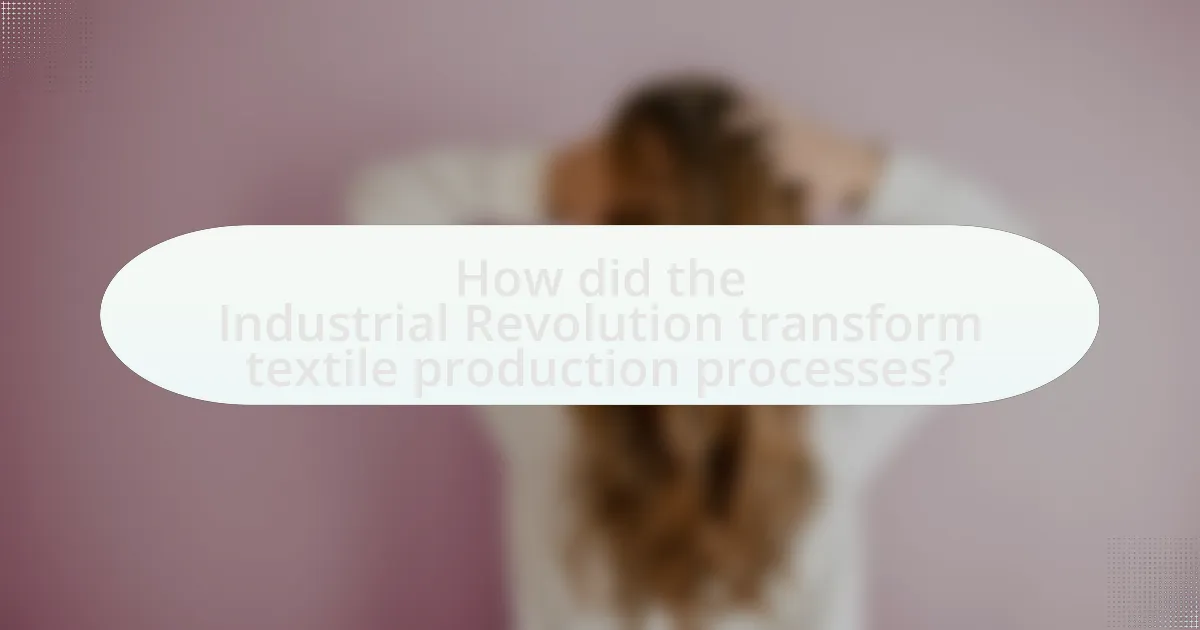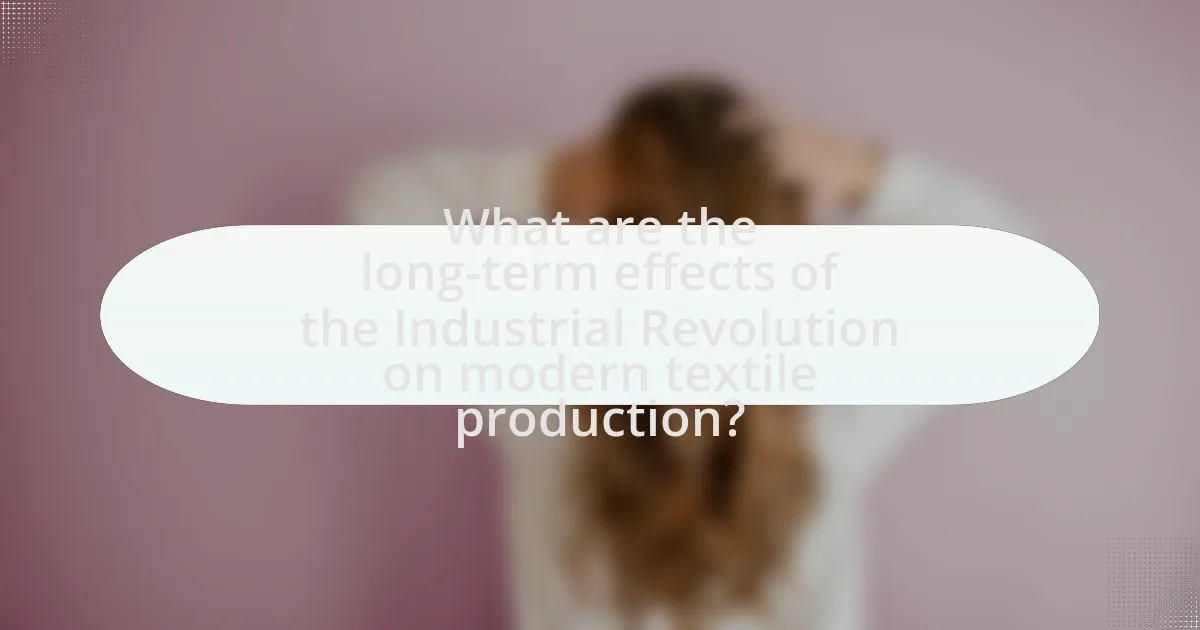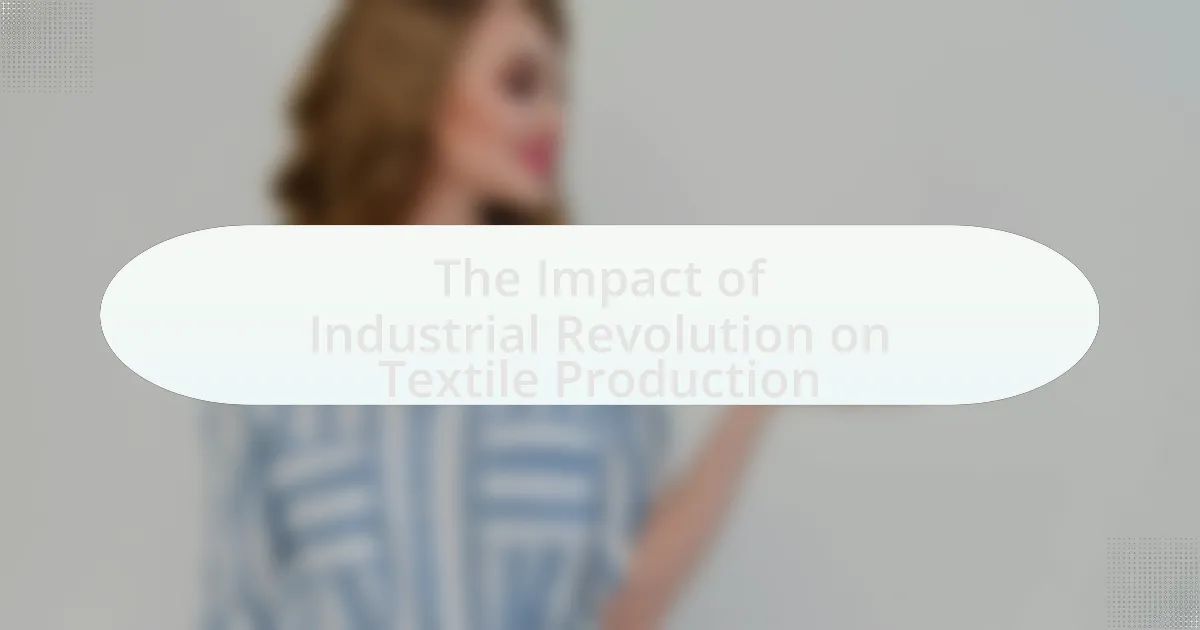The article examines the profound impact of the Industrial Revolution on textile production, highlighting key technological advancements such as the spinning jenny, water frame, and power loom that revolutionized manufacturing processes. It discusses the socio-economic effects on textile workers, including changes in labor conditions, wages, and the prevalence of child labor. Additionally, the article addresses environmental concerns arising from industrialized textile production, including pollution and resource depletion, while exploring the long-term effects on modern manufacturing practices and globalization. The analysis emphasizes the lessons learned from this historical period, particularly regarding the balance between efficiency and sustainability in contemporary textile production.

What was the Industrial Revolution and how did it influence textile production?
The Industrial Revolution was a period of significant technological advancement and industrial growth that began in the late 18th century and continued into the 19th century, fundamentally transforming economies from agrarian to industrial. This revolution greatly influenced textile production by introducing mechanized processes, such as the spinning jenny and the power loom, which increased production speed and efficiency. For instance, the introduction of the power loom in the 1780s allowed for the mass production of woven fabrics, drastically reducing the labor required and lowering costs. Consequently, textile manufacturing became one of the first industries to experience large-scale industrialization, leading to the establishment of factories and a shift in labor dynamics, as workers moved from rural areas to urban centers for employment.
What were the key technological advancements during the Industrial Revolution?
The key technological advancements during the Industrial Revolution included the spinning jenny, the water frame, and the power loom. The spinning jenny, invented by James Hargreaves in 1764, allowed one worker to spin multiple spools of thread simultaneously, significantly increasing yarn production. The water frame, developed by Richard Arkwright in 1769, utilized water power to produce stronger and finer yarn, which was essential for the textile industry. The power loom, invented by Edmund Cartwright in 1785, mechanized the weaving process, further enhancing productivity and reducing labor costs. These innovations collectively transformed textile production, leading to mass production and the establishment of factories, which were pivotal in the Industrial Revolution.
How did the spinning jenny change textile manufacturing?
The spinning jenny revolutionized textile manufacturing by significantly increasing yarn production efficiency. Invented by James Hargreaves in 1764, this multi-spindle spinning frame allowed a single worker to spin multiple threads simultaneously, enhancing productivity compared to traditional spinning methods. Historical data indicates that the spinning jenny could produce up to eight spools of yarn at once, which drastically reduced labor costs and time required for spinning. This innovation contributed to the growth of the textile industry during the Industrial Revolution, facilitating mass production and leading to the establishment of factories that could operate on a larger scale.
What role did the power loom play in increasing production efficiency?
The power loom significantly increased production efficiency by automating the weaving process, allowing for faster and more consistent fabric production. Introduced in the late 18th century, the power loom could produce cloth at a rate much higher than manual looms, with some estimates indicating that it could weave fabric up to five times faster. This automation reduced labor costs and minimized human error, leading to a more streamlined production process. By 1850, the use of power looms in factories had transformed the textile industry, contributing to a dramatic increase in output and enabling mass production of textiles, which was essential for meeting the growing demand during the Industrial Revolution.
What were the socio-economic impacts of the Industrial Revolution on textile workers?
The socio-economic impacts of the Industrial Revolution on textile workers included significant changes in labor conditions, wages, and living standards. Textile workers faced long hours, often exceeding 12 hours a day, in hazardous environments, leading to health issues and accidents. Wages initially increased due to high demand for textile production, but they often remained low relative to the cost of living, resulting in economic hardship for many families. The introduction of machinery reduced the need for skilled labor, leading to job displacement and increased unemployment among artisans. Additionally, urbanization forced many workers to relocate to cities, where they encountered overcrowded living conditions and inadequate sanitation. These factors collectively contributed to a decline in the overall quality of life for textile workers during this period.
How did working conditions in textile factories evolve during this period?
Working conditions in textile factories evolved significantly during the Industrial Revolution, transitioning from hazardous and exploitative environments to more regulated and safer workplaces. Initially, factories operated with minimal oversight, leading to long hours, poor ventilation, and unsafe machinery, which resulted in high injury rates and health issues among workers. Over time, labor movements and reforms prompted the introduction of regulations, such as the Factory Acts in the UK, which limited working hours, improved safety standards, and mandated breaks. By the late 19th century, these changes contributed to a gradual improvement in conditions, including better wages and the establishment of labor unions advocating for workers’ rights.
What were the effects of child labor in the textile industry?
Child labor in the textile industry led to severe physical and psychological effects on children, including stunted growth, chronic health issues, and emotional trauma. Children, often as young as five, worked long hours in hazardous conditions, which resulted in injuries from machinery and exposure to toxic substances. Historical data indicates that child laborers faced a higher risk of respiratory diseases due to poor ventilation in factories. Additionally, the exploitation of child labor contributed to the perpetuation of poverty, as families relied on the meager wages earned by their children, which hindered access to education and better opportunities. This cycle of poverty and lack of education had long-term societal implications, reinforcing class divisions and limiting social mobility.

How did the Industrial Revolution transform textile production processes?
The Industrial Revolution transformed textile production processes by introducing mechanization, which significantly increased efficiency and output. Innovations such as the spinning jenny, invented by James Hargreaves in 1764, allowed a single worker to spin multiple spools of thread simultaneously, drastically reducing labor time. The power loom, developed by Edmund Cartwright in 1785, automated the weaving process, further enhancing productivity. By the early 19th century, factories emerged as centralized locations for textile manufacturing, replacing traditional cottage industries and enabling mass production. This shift not only lowered costs but also made textiles more accessible to the general population, fundamentally altering the industry and consumer habits.
What new methods of production emerged in the textile industry?
New methods of production that emerged in the textile industry during the Industrial Revolution include the spinning jenny, the water frame, and the power loom. The spinning jenny, invented by James Hargreaves in 1764, allowed a single worker to spin multiple spools of thread simultaneously, significantly increasing yarn production. The water frame, developed by Richard Arkwright in 1769, utilized water power to drive spinning machines, enabling the production of stronger and finer yarns. The power loom, invented by Edmund Cartwright in 1785, mechanized the weaving process, drastically reducing the time and labor required to produce fabric. These innovations collectively transformed textile manufacturing, leading to increased efficiency and output in the industry.
How did mechanization alter traditional hand-weaving practices?
Mechanization significantly transformed traditional hand-weaving practices by introducing machines that increased production speed and efficiency. The advent of the power loom in the early 19th century allowed for the mass production of textiles, which drastically reduced the need for skilled hand-weavers. For instance, while a skilled artisan could produce a limited number of yards of fabric in a day, a power loom could produce hundreds, leading to a decline in the demand for hand-woven goods. This shift not only diminished the economic viability of traditional weaving but also altered the social fabric of communities reliant on hand-weaving, as many artisans were displaced from their trades.
What innovations in dyeing and finishing processes were introduced?
Innovations in dyeing and finishing processes during the Industrial Revolution included the introduction of synthetic dyes, such as aniline dyes, which allowed for a broader range of colors and improved colorfastness. The development of continuous dyeing techniques also revolutionized the industry by increasing efficiency and reducing labor costs. Additionally, advancements in finishing processes, such as mercerization, enhanced the strength and luster of cotton fabrics. These innovations significantly transformed textile production, leading to higher quality products and greater market availability.
What were the environmental impacts of industrialized textile production?
Industrialized textile production significantly harmed the environment through pollution, resource depletion, and waste generation. The introduction of synthetic dyes and chemicals in the manufacturing process led to the contamination of water bodies, with studies indicating that textile dyeing is responsible for approximately 20% of global water pollution. Additionally, the high demand for cotton resulted in extensive pesticide and water usage, contributing to soil degradation and water scarcity. The production process also generated substantial amounts of solid waste, with the fashion industry alone producing over 92 million tons of waste annually. These impacts highlight the detrimental effects of industrialized textile production on ecosystems and natural resources.
How did pollution levels change with the rise of textile factories?
Pollution levels significantly increased with the rise of textile factories during the Industrial Revolution. The establishment of these factories led to the release of large quantities of pollutants, including particulate matter, chemicals, and dyes, into the air and waterways. For instance, in the early 19th century, cities like Manchester and Lowell experienced severe air pollution due to coal combustion and the discharge of untreated wastewater from textile mills, which contaminated local rivers. Historical data indicates that by the mid-1800s, urban areas with concentrated textile production reported elevated levels of respiratory diseases and environmental degradation, underscoring the direct correlation between factory proliferation and pollution escalation.
What measures were taken to address environmental concerns in textile production?
Measures taken to address environmental concerns in textile production include the implementation of sustainable practices such as water recycling, the use of organic materials, and the adoption of eco-friendly dyes. Water recycling systems reduce the consumption of freshwater and minimize wastewater discharge, while organic materials decrease reliance on harmful pesticides and fertilizers. Additionally, eco-friendly dyes are less toxic and reduce pollution in water bodies. According to the Global Fashion Agenda’s 2020 report, these practices can significantly lower the environmental footprint of textile production, demonstrating a commitment to sustainability in the industry.

What are the long-term effects of the Industrial Revolution on modern textile production?
The long-term effects of the Industrial Revolution on modern textile production include increased efficiency, mass production capabilities, and the globalization of textile supply chains. The introduction of mechanized looms and spinning machines during the Industrial Revolution significantly enhanced production speed and reduced labor costs, leading to the establishment of factories that could produce textiles at an unprecedented scale. This shift laid the groundwork for modern manufacturing processes, where automation and technology continue to drive efficiency. Furthermore, the Industrial Revolution facilitated the development of global trade networks, allowing textiles to be produced in one region and consumed in another, which remains a hallmark of the industry today. For instance, the rise of synthetic fibers in the 20th century can be traced back to innovations initiated during this period, demonstrating the lasting impact of the Industrial Revolution on the materials and methods used in textile production.
How did the Industrial Revolution lay the groundwork for contemporary textile manufacturing?
The Industrial Revolution established the foundation for contemporary textile manufacturing by introducing mechanization and innovative production techniques. The advent of machines such as the spinning jenny and the power loom significantly increased production efficiency and reduced labor costs, allowing for mass production of textiles. This shift from handcrafting to machine-based manufacturing not only enhanced output but also improved the consistency and quality of textile products. Additionally, the development of the factory system centralized production, enabling better management of labor and resources, which is a hallmark of modern textile manufacturing. The introduction of steam power further accelerated production capabilities, leading to the establishment of a global textile industry that relies on these principles today.
What lasting changes in production techniques can be traced back to this era?
The Industrial Revolution introduced mechanization in textile production, leading to lasting changes such as the shift from handloom weaving to power looms. This transition significantly increased production speed and efficiency, allowing for mass production of textiles. The introduction of the spinning jenny in 1764 and the water frame in 1769 exemplified this shift, enabling a single worker to produce multiple threads simultaneously. These innovations laid the groundwork for modern manufacturing processes, establishing principles of assembly line production and automation that are still in use today.
How has globalization influenced the textile industry since the Industrial Revolution?
Globalization has significantly influenced the textile industry since the Industrial Revolution by facilitating the expansion of production networks and increasing market access. The Industrial Revolution marked the beginning of mechanized textile production, which laid the groundwork for global supply chains. As trade barriers diminished and communication technologies advanced, textile manufacturers began sourcing raw materials and labor from various countries, leading to cost reductions and increased efficiency. For instance, countries like China and India became major players in textile manufacturing due to their lower labor costs and abundant resources, resulting in a shift of production from Western nations to these emerging markets. This shift has led to a dramatic increase in global textile trade, with the World Trade Organization reporting that textile and apparel exports reached approximately $800 billion in 2019, illustrating the profound impact of globalization on the industry.
What lessons can be learned from the Industrial Revolution for today’s textile industry?
The primary lesson learned from the Industrial Revolution for today’s textile industry is the importance of technological innovation in enhancing production efficiency. During the Industrial Revolution, inventions such as the spinning jenny and the power loom significantly increased textile output and reduced labor costs. For instance, the spinning jenny, invented by James Hargreaves in 1764, allowed a single worker to spin multiple spools of thread simultaneously, which revolutionized the production process.
Today’s textile industry can apply this lesson by investing in automation and advanced manufacturing technologies, such as digital printing and smart textiles, to improve productivity and meet consumer demands for faster turnaround times. Additionally, the Industrial Revolution highlighted the need for a skilled workforce capable of operating new machinery, emphasizing the importance of training and education in modern textile production. This historical context demonstrates that embracing innovation and workforce development are crucial for sustaining competitiveness in the textile sector.
How can modern textile manufacturers balance efficiency and sustainability?
Modern textile manufacturers can balance efficiency and sustainability by adopting advanced technologies such as automation and sustainable materials. Automation increases production speed and reduces labor costs, while sustainable materials, like organic cotton or recycled polyester, minimize environmental impact. For instance, a study by the Ellen MacArthur Foundation highlights that using recycled materials can reduce greenhouse gas emissions by up to 70% compared to virgin materials. Additionally, implementing energy-efficient processes, such as waterless dyeing technologies, can further enhance sustainability without sacrificing productivity.
What best practices can be adopted from historical textile production methods?
Best practices that can be adopted from historical textile production methods include the use of natural fibers, hand-weaving techniques, and localized production systems. Natural fibers, such as cotton, wool, and linen, were historically favored for their biodegradability and lower environmental impact compared to synthetic alternatives. Hand-weaving techniques, prevalent before industrialization, allowed for greater craftsmanship and quality control, resulting in durable textiles. Localized production systems minimized transportation emissions and supported community economies, fostering sustainable practices. Historical evidence shows that these methods contributed to lower waste and a more sustainable approach to textile production, which can inform modern practices in the industry.

Leave a Reply